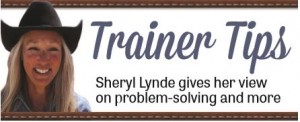 Are you noticing changes in your horse’s attitude when he is being handled or under saddle that is causing you to be concerned? Is he more attentive to pasture mates and other horses when out on the trail than he is on you? Do you feel “out-of-your-depth” when you try to safely identify and resolve the unwanted behaviors? Well, he could be challenging your position in the pecking order. It’s possible you have been fired!
Are you noticing changes in your horse’s attitude when he is being handled or under saddle that is causing you to be concerned? Is he more attentive to pasture mates and other horses when out on the trail than he is on you? Do you feel “out-of-your-depth” when you try to safely identify and resolve the unwanted behaviors? Well, he could be challenging your position in the pecking order. It’s possible you have been fired!
The following describes two different scenarios that lead to identical outcomes.
Scenario 1: A 3-year-old colt has been professionally started and trained and is now home. He is sensitive and compliant. However, his training fades as time goes by, and his responses to normal stimuli are overreactive. He exhibits new behaviors like head shyness and begins to flinch to sudden movements. He is now nervous while being saddled and even offers to pull back. Instead of giving softly to the bit, he tugs on your hands, tosses his head and acts offended by your leg-yield requests by swishing his tail. Though once he walked with purpose, he now drags his feet, sometimes stopping and refusing to move forward. When riding with a stablemate, if his buddy gets too far ahead, he initiates a rear and kicks out until, finally, he bucks and you fall off. You’ve been fired.
Scenario 2: A 3-year-old colt has been handled, ponied, and saddled by the owner since it was a yearling. As time for the first ride approaches, the owner hires someone for 30 days to get the youngster at a walk, trot and cantor. After 30 days, the colt can be ridden under saddle at all three gaits, but there is no steering or brakes. Yes, good training takes time, but she noticed holes in the training that were concerning. His behavior on the ground is disrespectful and at times, aggressive. This colt’s confident behavior transformed into belligerent conduct. When the owner tried mounting, she had to dodge a kick. While leading or entering his stall, he pushed into her space. While trying to ride into an arena setting, there was no steering or speed control. He would choose what speed and he would often stop and refuse to go forward. When a fellow horse rode away, he was unmanageable and offered to buck. You’ve been fired.
Each horse mentioned above has opposing temperaments. While one is sensitive and overreactive, the other is fearless to the point of being aggressive. However, both horses’ unwanted behaviors increased in severity until culminating in a buck. Bucking is used to establish a pecking order. The unwelcomed behaviors are the horses’ natural instinct to test your role as leader in the partnership, and they will continue to do so if left uncorrected. The bucking is a symptom. The cause is a role change in the pecking order. You have just been handed a “Dear John letter.”
How to regain your position.
Scenario 1 The horse needs to be shown the appropriate response to normal activities. Be aware of your surroundings while training — safety is first. Try not to sneak around a fearful horse. If they throw their head and attempt to bolt when you raise your arm, keep raising your arm with the same intensity until he stops moving his feet and tossing his head. It’s important to remain calm and relaxed when he elevates his emotions which is counterintuitive. The point is to set an example for him to follow. When his eye is soft, give him a complete release. Repeat as necessary until he stops reacting to raising your arm or whatever has caused him to react. If he drags his feet while you are leading him, the horse you lead is the horse you ride. Expect the same behavior while riding. On the ground, give him a spank on his hip with the end of your lead rope and ask him to step it up until he willingly leads next to you.
Scenario 2 The horse needs a visit to manners town. Begin by teaching him to back up and move away from you on the ground. Backing up is a submissive action for a horse to perform. In a herd-setting, you will not see a dominant horse backing up to a pasture mate. Every time your horse steps into your space and causes you to take a step back, you are losing your position in the pecking order. Every step he takes into your space needs to be corrected with a request to back up. Freeing up his feet on the ground will help while initiating the back-up in the saddle.
By identifying and correcting behaviors at the time they happen, you will eliminate the buck down the road.
~Sheryl
Leave a Comment
All fields must be filled in to leave a message.